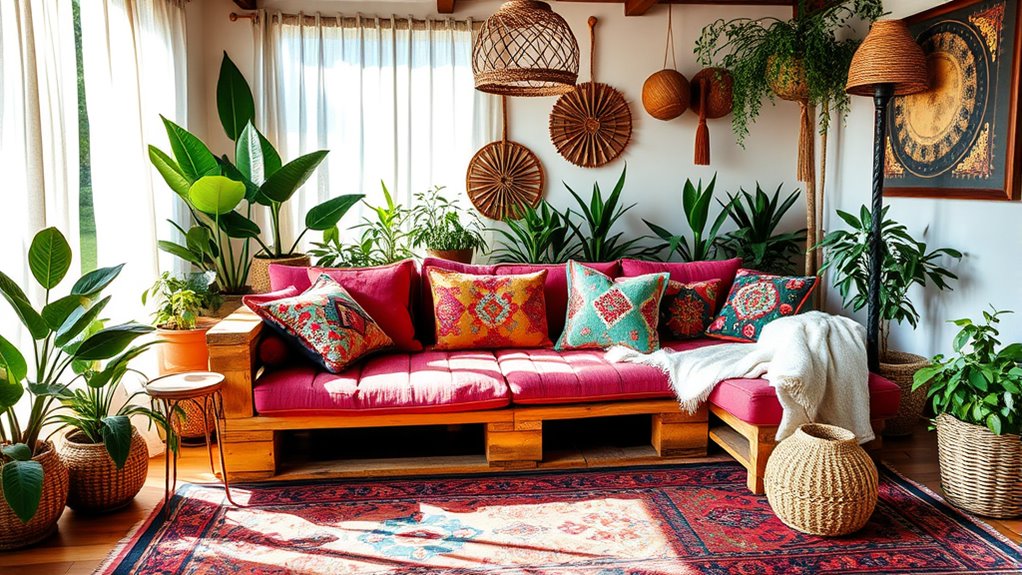To craft a bohemian sofa, bed, or table from pallets, start by choosing sturdy, untreated pallets stamped as eco-friendly and free of mold, pests, or chemicals. Prepare them by cleaning, inspecting, removing hardware, and sanding surfaces for a smooth finish. Next, assemble your design with secure joints and support beams, then add cushions, textiles, and decorative touches to achieve your boho aesthetic. Continue exploring these steps for a stylish, personalized piece that’s both eco-conscious and functional.
Key Takeaways
- Select high-quality, untreated pallets stamped with MB or EUR for safety and durability in boho furniture projects.
- Thoroughly clean, sand, and remove hardware to create smooth surfaces suitable for painting or staining.
- Plan your design, measure space, and reinforce pallets with support beams and heavy-duty screws for stability.
- Customize with vibrant paints, stains, or distressing techniques to achieve a rustic boho aesthetic.
- Add decorative textiles, cushions, and lighting to enhance comfort and create a cozy, bohemian vibe.
Selecting the Perfect Pallets for Your Project

How do you choose the right pallets for your furniture project? First, focus on pallets made from quality wood—hardwood or dense softwood—for durability, especially outdoors. Look for pallets with clear ISPM stamps like MB or EUR, ensuring they’re chemical-free and safe for DIY furniture. When inspecting, avoid pallets with mold, stains, pests, or spills to prevent health risks and damage down the line. Opt for sturdy, well-maintained pallets with no broken boards or loose nails, and make sure to sand and clean them thoroughly before starting your project. Carefully disassemble the pallets, checking each plank for damage. Choose those with smooth surfaces and minimal splintering for a polished, professional finish that lasts. Additionally, selecting pallets with proper ventilation can help prevent moisture buildup and prolong the lifespan of your furniture, which is crucial for maintaining sound structural integrity over time.
Preparing and Cleaning Your Pallets

Before building, you need to guarantee your pallets are safe and clean. Start by choosing pallets free of mold, chemicals, and pests, and wash them thoroughly to remove dirt and dust. Then, sand the surfaces to eliminate splinters and hardware, and consider sealing or bleaching if needed for added safety. Ensuring proper pest control and sanitation practices in your pallet preparation helps prevent spoilage and maintains safety for your furniture project. Incorporating material safety standards during preparation can further enhance the durability and safety of your finished piece. Additionally, verifying that your pallets meet modern toilet water efficiency standards can be beneficial if plumbing connections are involved. Proper cleaning and adherence to safety guidelines are essential to create a safe and durable piece of furniture. Moreover, paying attention to retirement planning principles can help you budget effectively for your DIY projects and future needs.
Choosing Safe Pallets
Choosing safe pallets is essential to guarantee your furniture project is both durable and non-toxic. Focus on pallet safety by selecting pallets with ISPM stamps like MB or EUR, which indicate untreated, food-safe wood free of pests. Avoid pallets showing mold, chemical stains, bird droppings, or signs of pests, as these can pose health risks. Before use, thoroughly clean your pallets with a hose or pressure washer to remove dirt, dust, and surface contaminants. Sand the surfaces with coarse sandpaper or a mouse sander to eliminate splinters, rough edges, and residual debris, ensuring safety during handling and assembly. If pallets have strong odors or visible contamination, consider bleaching or natural cleaning agents to make them safe for indoor or outdoor furniture projects. Additionally, inspecting pallets for safety compliance can help prevent potential health hazards and ensure they meet regulatory standards. Proper cleaning and inspection also help in extending the lifespan of your furniture, making your DIY project more sustainable and long-lasting. Conducting a thorough examination before assembly can further ensure the integrity and safety of your finished piece. Incorporating sustainable practices during preparation not only protects your health but also supports eco-friendly woodworking.
Proper Cleaning Techniques
To guarantee your pallets are safe and ready for furniture building, start by thoroughly washing them with a hose or pressure washer to remove dirt, dust, and debris. Proper cleaning is essential to prep the wood for safe use. After washing, inspect for any staples, nails, or hardware, and remove or hammer them flush to prevent injuries and protect your tools. Use a wire brush to scrub the surface, ensuring all loose particles are cleared for a smooth finish. If you notice mold, stains, or pests, disinfect or bleach the wood to sanitize and eliminate potential hazards. Additionally, low-carb meal options like turkey bean and tomato zoodle bowls or shrimp and potato Caesar salads can inspire your outdoor dining setup while working on your furniture. Checking for wood treatment issues ensures your pallets are free from chemicals or treatments that could be harmful. Remove all hardware for safe handling. Use tools effectively for thorough cleaning. Disinfect to prevent mold and pests. Check for damage to ensure durability. Proper prep extends your furniture’s lifespan, and understanding pallet safety standards can help you avoid potential health risks associated with treated wood. Moreover, being aware of sustainable materials can guide you in choosing eco-friendly options for your project. To further ensure safety, consider researching treatment types to identify any potentially hazardous chemicals used during manufacturing.
Sanding and Finishing
After thoroughly cleaning your pallets and removing any hardware, the next step is to prepare their surfaces for finishing. Begin by sanding the pallets with a 125mm random orbital sander or sandpaper to eliminate splinters and rough spots, ensuring a safe and smooth finish. Check for staples, nails, or hardware before sanding to prevent damage to your tools. Once sanded, use a wire brush to remove dust and debris, which helps improve adhesion for paint or stain. Additionally, selecting the right sanding tools can make the process more efficient and effective. Clean the pallets with a damp cloth or hose to remove residual dust and dirt. If needed, seal the wood with paint, stain, or a protective finish, and consider applying wax for added durability. Using the right spray tips can also help achieve an even coat and a professional appearance. Proper sanding and finishing create a polished look and extend your furniture’s lifespan. Incorporating proper surface preparation techniques can also prevent future issues such as peeling or cracking, ensuring your furniture remains beautiful and durable over time.
Designing Your Boho-Inspired Furniture Piece

Designing your boho-inspired furniture piece starts with careful planning to guarantee it reflects your personal style and fits your space. Choose pallets that are safe, untreated, and properly stamped, ensuring your DIY project is eco-friendly and upcycled furniture. Measure your area and plan dimensions, considering weight and stability, especially for a sofa or bed. Sand and paint or stain the white wood pallets to match your boho style—think vibrant colors or natural finishes. Incorporate decorative elements like cushions, throws, and textiles to soften the rustic look. Add a plant shelf or hanging greenery to bring life to your piece. Remember, thoughtful design transforms simple pallets into a unique centerpiece that combines functionality with aesthetic charm. When selecting your materials, consider using dyes to customize your pallets’ color and enhance your boho aesthetic. Additionally, understanding structural integrity is crucial to ensure your furniture remains durable and safe for everyday use, especially when involving playful or creative elements inspired by Waldorf toys, which emphasize safety and natural materials.
A well-designed piece also takes into account ergonomic comfort, ensuring that your furniture is not only beautiful but also practical for daily use.
Assembling the Base Structure

Before assembling your pallet furniture, choose only sturdy, chemical-free pallets free of mold or pests to guarantee safety and durability. Start by arranging your pallets into the desired structure, ensuring they fit snugly. Use a measuring tape to mark precise cut lines if needed. Secure the pallets together with a drill and heavy-duty screws, focusing on tight joints to enhance stability. To support the structure, add support beams like 2x4s underneath or between pallets for extra strength. Keep in mind: WWE Raw’s Financial Impact and the importance of a solid foundation in all ventures. This approach guarantees a sturdy, safe base for your DIY furniture project, especially considering the family photoshoot fails that can occur when stability is overlooked.
Sanding and Smoothing Surfaces

To achieve a smooth and safe surface for your pallet furniture, you should start by thoroughly inspecting each pallet for staples or nails and removing them. Then, use a 125mm random orbital sander with medium-grit (120-150) sandpaper to tackle rough edges and begin the sanding process. This surface preparation step removes splinters and creates a safer, more comfortable finish. Remember to wear safety gear, including a dust mask and safety goggles, to protect against wood dust and splinters. After the initial sanding, use a wire brush to clean off dust and debris, enhancing surface smoothness. For an even softer finish, finish with fine-grit (220) sandpaper, preparing the wood for your desired wood finish, paint, or sealant. Proper sanding ensures durability and a professional look.
Painting or Staining for a Bohemian Look

Painting or staining your pallet furniture is a great way to achieve that relaxed bohemian look. Bright or earthy colors like turquoise, terracotta, or deep blues make your piece vibrant and lively. Staining with natural or dark wood tones creates a warm, rustic vibe that fits boho decor perfectly. Using chalk paint allows for easy distressing, giving your furniture a vintage, lived-in finish. To add texture and depth, apply multiple layers of stain or paint with a dry brush technique, enhancing the relaxed, layered feel of boho style. Once you’re satisfied, seal your work with a matte or satin finish to guarantee durability while maintaining that laid-back, effortless aesthetic. This process lets you customize your furniture to fit your unique bohemian space.
Adding Cushions and Textiles for Comfort

Ever thought about how adding cushions can instantly transform your pallet furniture into a cozy retreat? By layering cushions and textiles, you create an inviting, comfortable space that invites relaxation. Use weather-resistant cushions for outdoor durability, ensuring they withstand the elements while maintaining comfort. Incorporate a variety of textiles like throws and blankets to add texture and visual interest, making your furniture unique and boho-chic. Cover your cushions with fleece or faux fur throws, which can be flipped for extra coziness and longevity. Choosing cushions from brands like H&M Home or WestwingNow offers options like embroidered, fringed, or faux fur styles, amplifying your layered, bohemian aesthetic. These simple touches make your pallet furniture irresistibly comfy and stylish.
Incorporating Decorative Elements and Accessories

Incorporating decorative elements and accessories can instantly elevate your pallet furniture from simple to stunning. Adding decorative accessories like cushions, throws, and garlands transforms your pieces into cozy, personalized boho-chic accents. Textile accents such as embroidered cushions and faux fur throws add texture and visual interest, perfect for both outdoor and indoor spaces. Incorporate affordable DIY decor items, like Mother of Pearl garlands from DIY stores, to enhance the rustic charm of your furniture. Ambient lighting, such as lanterns or fairy lights, creates a warm, inviting atmosphere around your seating area. By combining recycled or handmade accessories, you develop a unique, budget-friendly aesthetic that reflects your personal style, making your pallet furniture truly one-of-a-kind and welcoming.
Final Assembly and Stability Checks

Before finalizing your pallet furniture, it’s essential to perform thorough stability checks to guarantee safety and durability. Start by ensuring all screws and hardware are securely fastened and countersunk to prevent injury and enhance stability. Use a spirit level to verify the levelness of your piece, correcting any uneven surfaces. If the structure feels loose or wobbly, reinforce joints with additional screws or brackets for added support. Regularly inspect your furniture for splinters, cracks, or loosened hardware, especially if exposed to outdoor elements. Finally, test the weight capacity by gradually applying pressure, ensuring your piece can support the intended load safely.
- Check all screws and hardware for security
- Confirm levelness with a spirit level
- Reinforce weak joints with extra screws or brackets
- Inspect for damage or loosened hardware regularly
- Test weight capacity gradually
Styling Tips to Complete Your Boho Vibe

To truly capture the boho vibe, focus on layering textures and natural elements throughout your pallet furniture setup. Use embellishments like embroidered cushions, faux fur throws, and Moroccan fringed cushions to add depth and tactile interest. Incorporate textiles in various patterns and sizes to create a relaxed, inviting atmosphere. Enhance the look with natural decor such as woven baskets, Mother of Pearl garlands, and recycled accessories, emphasizing earthy, eclectic charm. Add statement lighting like lanterns, fairy lights, or LED string lights to set a warm, cozy mood for evening gatherings. Stick to warm, neutral tones with weathered finishes for your furniture and decor pieces to maintain that rustic, boho aesthetic. Thoughtful layering of these elements completes your look effortlessly.
Frequently Asked Questions
How Many Pallets Do You Need for a Pallet Couch?
You’re wondering how many pallets you need for a pallet couch. Typically, 2 to 4 pallets suffice, depending on your desired size and style. For a small loveseat, 2 pallets work well. If you want a larger sofa or sectional, plan on using 3 or more. Measure your space and decide on the design to determine the exact number needed for a comfortable, personalized piece.
What Are the Disadvantages of Pallet Furniture?
The current question asks about the disadvantages of pallet furniture. Think of it as a double-edged sword—you get a unique piece, but it comes with drawbacks. You might face health risks from residual chemicals or pesticides, and the rough surfaces often need lots of sanding. Plus, outdoor pieces can warp or rot if not properly sealed. Pests and structural issues also pose challenges, so weigh these factors before diving in.
How to Turn Pallets Into a Couch?
To turn pallets into a couch, start by selecting sturdy, pest-free pallets and thoroughly sanding them. Arrange the pallets in a U or L shape for the base and backrest, then secure them with screws or brackets for stability. Add cushions and throws on top to make it comfy and inviting. To finish, you can add armrests or side tables using smaller pallets or reclaimed wood, enhancing the boho-chic style.
How Do You Make Pallets Look Nice?
To make pallets look nice, start by sanding them thoroughly to remove splinters and rough spots. Then, paint or stain with weather-resistant finishes to improve appearance and durability. Add decorative touches like cushions or throws to hide imperfections and create a cozy vibe. Arrange your pallets neatly, ensuring even gaps and alignment. Finally, incorporate accessories like lighting or textiles to enhance the rustic charm and make your space inviting.
Conclusion
With a little patience and a touch of creativity, you’ve turned simple pallets into a charming boho haven. Your cozy sofa, bed, or table now whispers stories of your unique style, blending comfort with artistry. As you step back to admire your handiwork, remember that every detail adds to the magic. Keep nurturing that creative spark—your space is a canvas waiting for even more beautiful touches to softly unfold.









